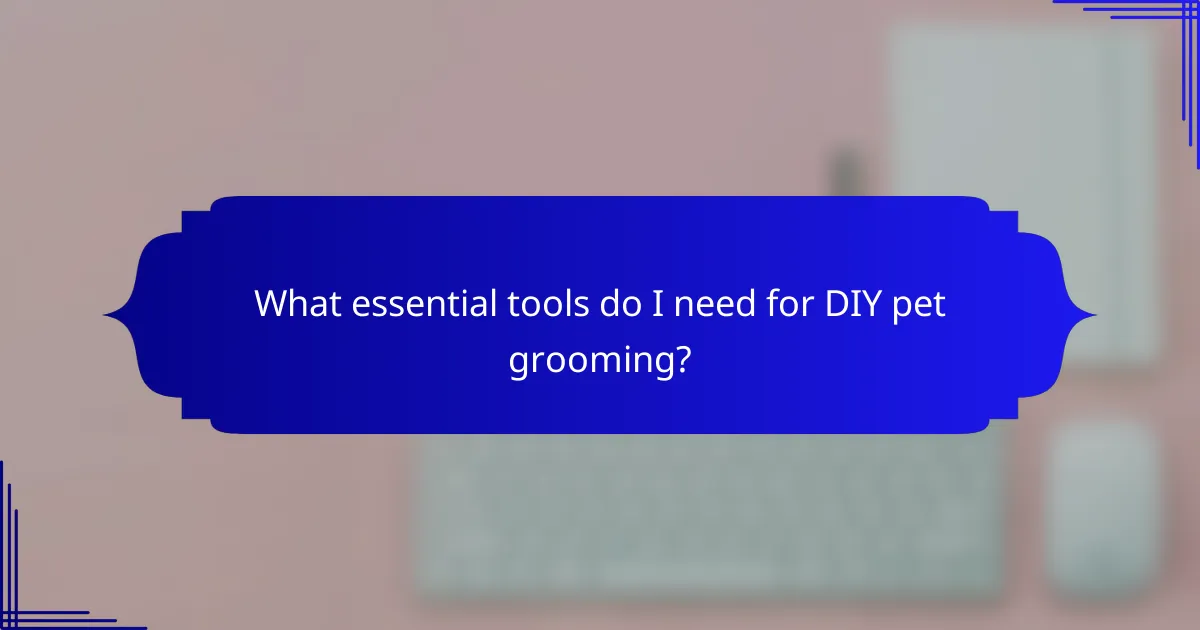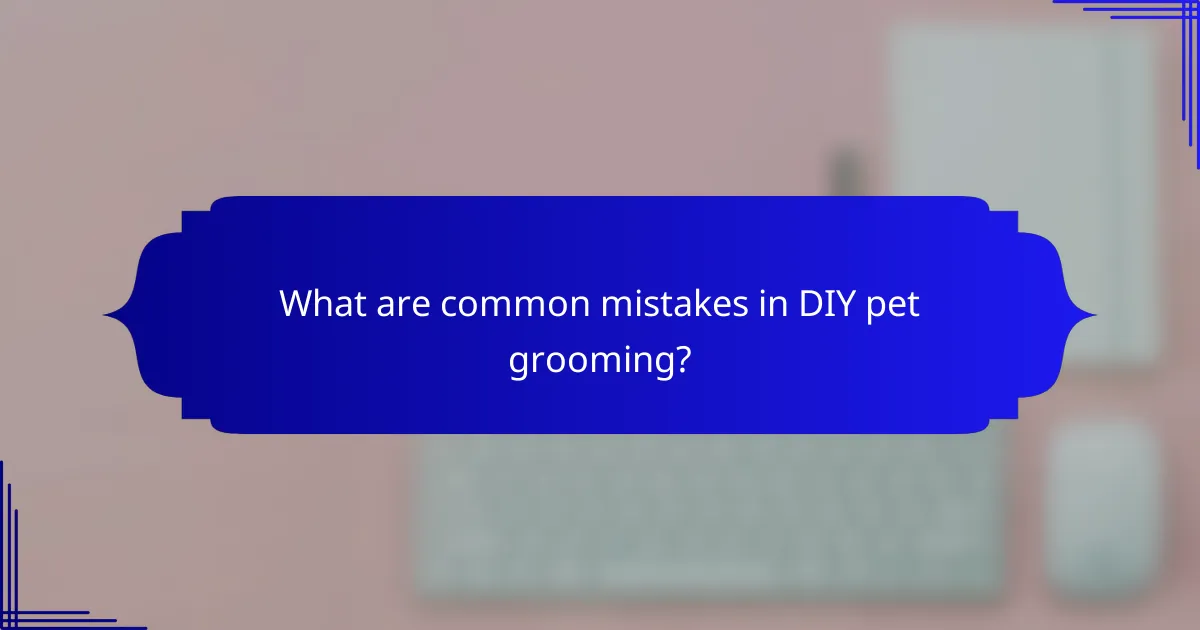DIY pet grooming is a fantastic way to save money while keeping your furry friend looking their best. By using budget-friendly tools and following step-by-step guides tailored to your pet’s needs, you can maintain their hygiene and appearance without the expense of professional services. Embracing a hands-on approach not only reduces costs but also strengthens the bond between you and your pet.

How can I save money on pet grooming in Australia?
Saving money on pet grooming in Australia can be achieved through DIY techniques, using budget-friendly tools, and understanding the trade-offs between home grooming and professional services. By taking a hands-on approach, you can significantly reduce grooming costs while ensuring your pet looks its best.
DIY grooming techniques
DIY grooming techniques involve basic practices like brushing, bathing, and nail trimming that you can perform at home. Regular brushing helps reduce shedding and matting, while occasional baths keep your pet clean without the need for professional services.
To get started, familiarize yourself with your pet’s grooming needs based on its breed and coat type. For example, long-haired breeds may require more frequent brushing compared to short-haired ones. Establish a routine that suits your pet’s comfort and needs.
Using budget-friendly tools
Investing in budget-friendly grooming tools can save you money in the long run. Essential tools include a good quality brush, nail clippers, and pet shampoo, all of which can be found at reasonable prices in Australia. Look for multi-functional tools that can serve several purposes.
Consider shopping at local pet stores or online retailers for discounts. Many tools are available for under AUD 50, making it easy to gather everything you need without breaking the bank. Always read reviews to ensure you’re getting quality products that will last.
Grooming at home vs. professional services
Grooming at home can be significantly cheaper than professional services, which can range from AUD 50 to AUD 150 depending on your pet’s size and the services required. However, consider your comfort level and skill in handling grooming tasks.
While home grooming saves money, it may not always achieve the same results as a professional groomer, especially for complex styles or breeds requiring specific techniques. Weigh the pros and cons, and consider a mix of both approaches, such as professional grooming for special occasions and DIY for regular maintenance.

What essential tools do I need for DIY pet grooming?
To effectively groom your pet at home, you’ll need a few essential tools that cater to their specific grooming needs. These tools will help you maintain your pet’s hygiene and appearance while saving on grooming costs.
Grooming clippers
Grooming clippers are vital for trimming your pet’s fur, especially for breeds with longer coats. Look for clippers that are quiet and have adjustable blade lengths to accommodate different fur types and lengths.
When selecting clippers, consider the size of your pet and their coat type. For example, heavy-duty clippers are better suited for thick fur, while lighter models work well for finer coats. Brands like Wahl and Andis are popular choices among pet owners.
Brushes for different fur types
Choosing the right brush is crucial for effective grooming. Different fur types require specific brushes; for instance, slicker brushes are great for removing tangles in long-haired pets, while bristle brushes work well for short-haired breeds.
Additionally, consider using a comb for pets with curly or wiry fur to prevent matting. Regular brushing not only keeps your pet’s coat healthy but also reduces shedding around your home.
Shampoo and conditioner recommendations
Selecting the right shampoo and conditioner is essential for maintaining your pet’s skin and coat health. Look for products that are specifically formulated for pets, as human shampoos can disrupt their skin’s pH balance.
For dogs, hypoallergenic and oatmeal-based shampoos are often recommended for sensitive skin. Cats typically require milder formulas. Brands like Earthbath and PetHead offer a range of options that cater to various needs.

What are the step-by-step guides for grooming different pets?
Grooming pets involves specific steps tailored to each type of animal, focusing on their unique needs. Understanding these guides can help you maintain your pet’s hygiene and appearance while saving on grooming costs.
Dog grooming guide
Start by brushing your dog’s coat to remove loose hair and prevent matting. Depending on the breed, this may require a slicker brush, bristle brush, or comb. Aim to brush at least once a week, or more frequently for long-haired breeds.
Next, bathe your dog using a pet-friendly shampoo. Wet their coat thoroughly, apply the shampoo, and rinse well to avoid skin irritation. Bathing frequency can vary, but every 4-6 weeks is a common guideline.
Don’t forget to trim your dog’s nails regularly, usually every 3-4 weeks, to prevent discomfort. If you’re unsure, a quick visit to a vet or groomer can provide guidance on proper nail care.
Cat grooming guide
Grooming cats primarily involves brushing to reduce shedding and hairballs. Long-haired cats may need daily brushing, while short-haired breeds can be groomed weekly. Use a comb or brush designed for cats to make the process easier.
Bathing cats is generally not necessary, but if your cat gets into something dirty, use a gentle cat shampoo. Ensure you rinse thoroughly to avoid any residue that could irritate their skin.
Regularly check and clean your cat’s ears and teeth. Use a damp cloth for ears and consider dental treats or brushing for oral hygiene. Aim for dental care at least a few times a week.
Small animal grooming guide
For small animals like rabbits or guinea pigs, grooming focuses on brushing and nail trimming. Brush your small pet weekly to remove loose fur and prevent matting, especially for long-haired breeds.
Bathing is usually unnecessary for small animals; instead, spot clean with a damp cloth when needed. Ensure their living area is clean to help maintain their hygiene.
Nail trimming is essential and should be done every 3-4 weeks. Use small animal nail clippers and be cautious not to cut too close to the quick, which can cause bleeding. If unsure, consult a vet for assistance.

What are the prerequisites for successful DIY pet grooming?
Successful DIY pet grooming requires understanding your pet’s specific grooming needs and creating a safe environment for the process. Proper tools and techniques are essential to ensure both the pet’s comfort and the effectiveness of the grooming session.
Understanding your pet’s grooming needs
Each pet has unique grooming requirements based on their breed, coat type, and health. Long-haired breeds may need more frequent brushing to prevent matting, while short-haired pets might require less maintenance. Regularly assess your pet’s coat condition and skin health to determine the appropriate grooming frequency.
Consider factors like shedding seasons, skin sensitivities, and any specific health issues your pet may have. For example, dogs with allergies may need hypoallergenic shampoos and more frequent baths, while cats may require less frequent grooming but need attention to their claws.
Creating a safe grooming environment
Establishing a safe grooming environment is crucial to prevent accidents and ensure your pet feels comfortable. Choose a quiet, well-lit area with enough space for both you and your pet to move around freely. Non-slip surfaces can help prevent slips and falls during grooming.
Gather all necessary tools beforehand, such as brushes, clippers, and grooming wipes, to minimize distractions. Always keep treats on hand to reward your pet for good behavior, and consider using a harness or leash to keep them secure during the grooming process.

How do I choose the right grooming products?
Choosing the right grooming products involves assessing your pet’s specific needs, coat type, and any sensitivities they may have. Look for products that are effective, safe, and suitable for your pet’s breed and size.
Comparing brands for effectiveness
When comparing grooming brands, consider their reputation and the effectiveness of their products. Look for reviews from other pet owners and check for endorsements from veterinarians or professional groomers.
Some popular grooming brands include PetSafe, Earthbath, and Furminator. Each brand may offer specialized products for different coat types, such as long-haired or short-haired pets, so choose accordingly.
Evaluating product safety for pets
Safety is crucial when selecting grooming products. Always check the ingredient list for harmful chemicals or allergens that could irritate your pet’s skin. Look for products labeled as hypoallergenic or specifically designed for sensitive skin.
Additionally, consider certifications from organizations like the Environmental Protection Agency (EPA) or the American Society for the Prevention of Cruelty to Animals (ASPCA), which can indicate a product’s safety. Avoid products with strong fragrances or dyes, as these can cause adverse reactions in pets.

What are common mistakes in DIY pet grooming?
Common mistakes in DIY pet grooming include over-bathing, using the wrong tools, and neglecting to check for skin issues. These errors can lead to skin irritation, stress for the pet, and ineffective grooming results.
Over-bathing pets
Over-bathing pets is a frequent mistake that can strip their skin of natural oils, leading to dryness and irritation. Most pets only need a bath every few weeks to a couple of months, depending on their breed and lifestyle.
To avoid over-bathing, assess your pet’s coat and skin condition. If they are not particularly dirty or smelly, consider skipping the bath. Instead, regular brushing can help remove dirt and loose fur without the need for frequent washing.
When you do bathe your pet, use a mild pet shampoo and ensure you rinse thoroughly to avoid residue. Always check the water temperature; it should be lukewarm to keep your pet comfortable during the process.
